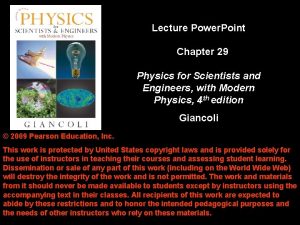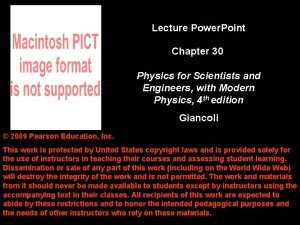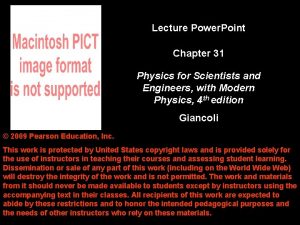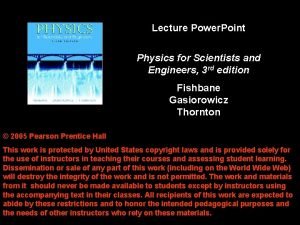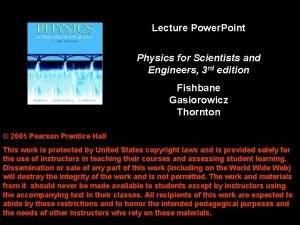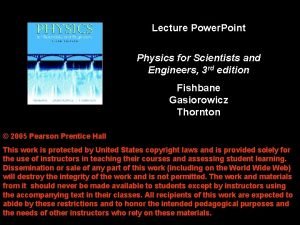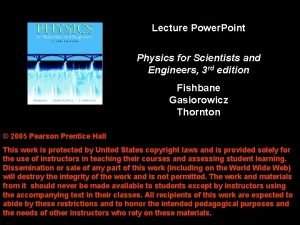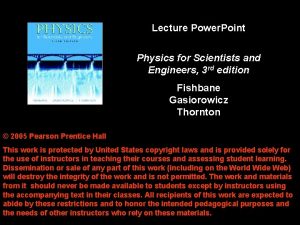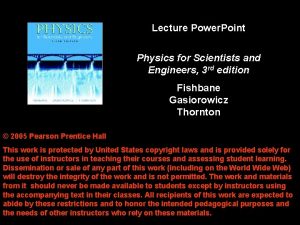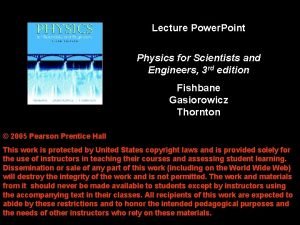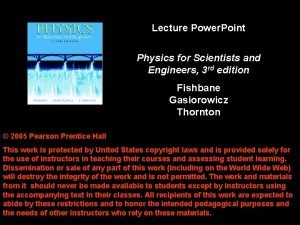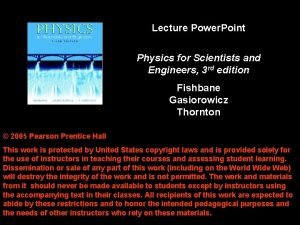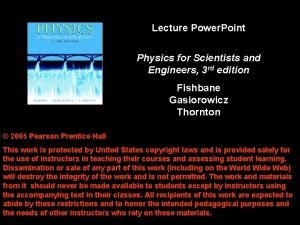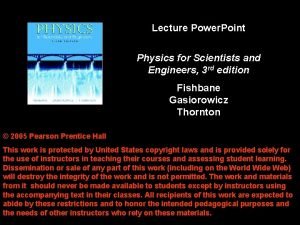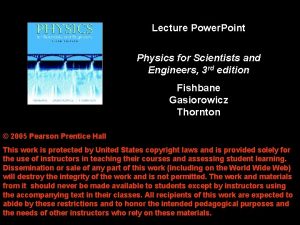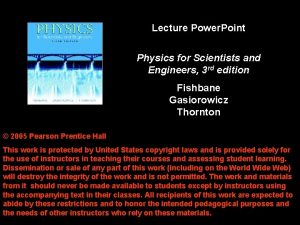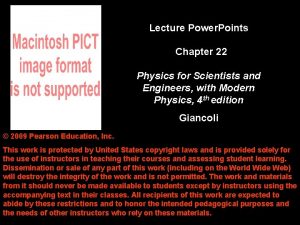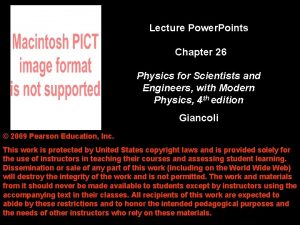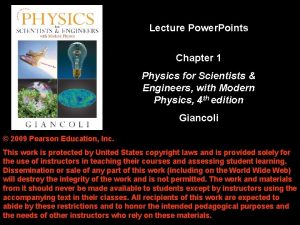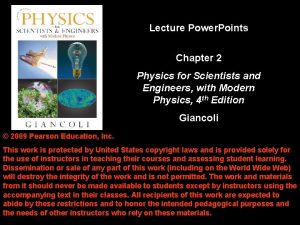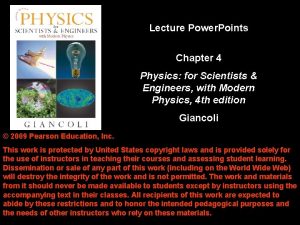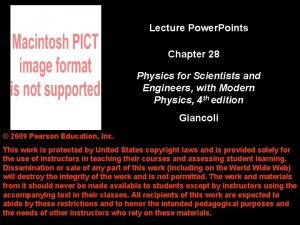Lecture Power Point Chapter 31 Physics for Scientists
















































- Slides: 48

Lecture Power. Point Chapter 31 Physics for Scientists and Engineers, with Modern Physics, 4 th edition Giancoli © 2009 Pearson Education, Inc. This work is protected by United States copyright laws and is provided solely for the use of instructors in teaching their courses and assessing student learning. Dissemination or sale of any part of this work (including on the World Wide Web) will destroy the integrity of the work and is not permitted. The work and materials from it should never be made available to students except by instructors using the accompanying text in their classes. All recipients of this work are expected to abide by these restrictions and to honor the intended pedagogical purposes and the needs of other instructors who rely on these materials.

Chapter 31 Maxwell’s Equations and Electromagnetic Waves Copyright © 2009 Pearson Education, Inc.

Units of Chapter 31 • Changing Electric Fields Produce Magnetic Fields; Ampère’s Law and Displacement Current • Gauss’s Law for Magnetism • Maxwell’s Equations • Production of Electromagnetic Waves • Electromagnetic Waves, and Their Speed, Derived from Maxwell’s Equations • Light as an Electromagnetic Wave and the Electromagnetic Spectrum Copyright © 2009 Pearson Education, Inc.

Units of Chapter 31 • Measuring the Speed of Light • Energy in EM Waves; the Poynting Vector • Radiation Pressure • Radio and Television; Wireless Communication Copyright © 2009 Pearson Education, Inc.

31 -1 Changing Electric Fields Produce Magnetic Fields; Ampère’s Law and Displacement Current Ampère’s law relates the magnetic field around a current to the current through a surface. Copyright © 2009 Pearson Education, Inc.

31 -1 Changing Electric Fields Produce Magnetic Fields; Ampère’s Law and Displacement Current In order for Ampère’s law to hold, it can’t matter which surface we choose. But look at a discharging capacitor; there is a current through surface 1 but none through surface 2: Copyright © 2009 Pearson Education, Inc.

31 -1 Changing Electric Fields Produce Magnetic Fields; Ampère’s Law and Displacement Current Therefore, Ampère’s law is modified to include the creation of a magnetic field by a changing electric field – the field between the plates of the capacitor in this example: Copyright © 2009 Pearson Education, Inc.

31 -1 Changing Electric Fields Produce Magnetic Fields; Ampère’s Law and Displacement Current Example 31 -1: Charging capacitor. A 30 -p. F air-gap capacitor has circular plates of area A = 100 cm 2. It is charged by a 70 -V battery through a 2. 0 -Ω resistor. At the instant the battery is connected, the electric field between the plates is changing most rapidly. At this instant, calculate (a) the current into the plates, and (b) the rate of change of electric field between the plates. (c) Determine the magnetic field induced between the plates. Assume E is uniform between the plates at any instant and is zero at all points beyond the edges of the plates. Copyright © 2009 Pearson Education, Inc.

31 -1 Changing Electric Fields Produce Magnetic Fields; Ampère’s Law and Displacement Current The second term in Ampere’s law has the dimensions of a current (after factoring out the μ 0), and is sometimes called the displacement current: where Copyright © 2009 Pearson Education, Inc.

31 -2 Gauss’s Law for Magnetism Gauss’s law relates the electric field on a closed surface to the net charge enclosed by that surface. The analogous law for magnetic fields is different, as there are no single magnetic point charges (monopoles): Copyright © 2009 Pearson Education, Inc.

31 -3 Maxwell’s Equations We now have a complete set of equations that describe electric and magnetic fields, called Maxwell’s equations. In the absence of dielectric or magnetic materials, they are: Copyright © 2009 Pearson Education, Inc.

31 -4 Production of Electromagnetic Waves Since a changing electric field produces a magnetic field, and a changing magnetic field produces an electric field, once sinusoidal fields are created they can propagate on their own. These propagating fields are called electromagnetic waves. Copyright © 2009 Pearson Education, Inc.

31 -4 Production of Electromagnetic Waves Oscillating charges will produce electromagnetic waves: Copyright © 2009 Pearson Education, Inc.

31 -4 Production of Electromagnetic Waves Close to the antenna, the fields are complicated, and are called the near field: Copyright © 2009 Pearson Education, Inc.

31 -4 Production of Electromagnetic Waves Far from the source, the waves are plane waves: Copyright © 2009 Pearson Education, Inc.

31 -4 Production of Electromagnetic Waves The electric and magnetic waves are perpendicular to each other, and to the direction of propagation. Copyright © 2009 Pearson Education, Inc.

31 -5 Electromagnetic Waves, and Their Speed, Derived from Maxwell’s Equations In the absence of currents and charges, Maxwell’s equations become: Copyright © 2009 Pearson Education, Inc.

31 -5 Electromagnetic Waves, and Their Speed, Derived from Maxwell’s Equations This figure shows an electromagnetic wave of wavelength λ and frequency f. The electric and magnetic fields are given by. where Copyright © 2009 Pearson Education, Inc.

31 -5 Electromagnetic Waves, and Their Speed, Derived from Maxwell’s Equations Applying Faraday’s law to the rectangle of height Δy and width dx in the previous figure gives a relationship between E and B: . Copyright © 2009 Pearson Education, Inc.

31 -5 Electromagnetic Waves, and Their Speed, Derived from Maxwell’s Equations Similarly, we apply Maxwell’s fourth equation to the rectangle of length Δz and width dx, which gives. Copyright © 2009 Pearson Education, Inc.

31 -5 Electromagnetic Waves, and Their Speed, Derived from Maxwell’s Equations Using these two equations and the equations for B and E as a function of time gives. Here, v is the velocity of the wave. Substituting, Copyright © 2009 Pearson Education, Inc.

31 -5 Electromagnetic Waves, and Their Speed, Derived from Maxwell’s Equations The magnitude of this speed is 3. 0 x 108 m/s – precisely equal to the measured speed of light. Copyright © 2009 Pearson Education, Inc.

31 -5 Electromagnetic Waves, and Their Speed, Derived from Maxwell’s Equations Example 31 -2: Determining E and B in EM waves. Assume a 60 -Hz EM wave is a sinusoidal wave propagating in the z direction with E pointing in the x direction, and E 0 = 2. 0 V/m. Write vector expressions for E and B as functions of position and time. Copyright © 2009 Pearson Education, Inc.

31 -6 Light as an Electromagnetic Wave and the Electromagnetic Spectrum The frequency of an electromagnetic wave is related to its wavelength and to the speed of light: Copyright © 2009 Pearson Education, Inc.

31 -6 Light as an Electromagnetic Wave and the Electromagnetic Spectrum Electromagnetic waves can have any wavelength; we have given different names to different parts of the wavelength spectrum. Copyright © 2009 Pearson Education, Inc.

31 -6 Light as an Electromagnetic Wave and the Electromagnetic Spectrum Example 31 -3: Wavelengths of EM waves. Calculate the wavelength (a) of a 60 -Hz EM wave, (b) of a 93. 3 -MHz FM radio wave, and (c) of a beam of visible red light from a laser at frequency 4. 74 x 1014 Hz. Copyright © 2009 Pearson Education, Inc.

31 -6 Light as an Electromagnetic Wave and the Electromagnetic Spectrum Example 31 -4: Cell phone antenna. The antenna of a cell phone is often ¼ wavelength long. A particular cell phone has an 8. 5 -cm-long straight rod for its antenna. Estimate the operating frequency of this phone. Copyright © 2009 Pearson Education, Inc.

31 -6 Light as an Electromagnetic Wave and the Electromagnetic Spectrum Example 31 -5: Phone call time lag. You make a telephone call from New York to a friend in London. Estimate how long it will take the electrical signal generated by your voice to reach London, assuming the signal is (a) carried on a telephone cable under the Atlantic Ocean, and (b) sent via satellite 36, 000 km above the ocean. Would this cause a noticeable delay in either case? Copyright © 2009 Pearson Education, Inc.

31 -7 Measuring the Speed of Light The speed of light was known to be very large, although careful studies of the orbits of Jupiter’s moons showed that it is finite. One important measurement, by Michelson, used a rotating mirror: Copyright © 2009 Pearson Education, Inc.

31 -7 Measuring the Speed of Light Over the years, measurements have become more and more precise; now the speed of light is defined to be c = 2. 99792458 × 108 m/s. This is then used to define the meter. Copyright © 2009 Pearson Education, Inc.

31 -8 Energy in EM Waves; the Poynting Vector Energy is stored in both electric and magnetic fields, giving the total energy density of an electromagnetic wave: Each field contributes half the total energy density: Copyright © 2009 Pearson Education, Inc.

31 -8 Energy in EM Waves; the Poynting Vector This energy is transported by the wave. Copyright © 2009 Pearson Education, Inc.

31 -8 Energy in EM Waves; the Poynting Vector The energy transported through a unit area per unit time is called the intensity: Its vector form is the Poynting vector: Copyright © 2009 Pearson Education, Inc.

31 -8 Energy in EM Waves; the Poynting Vector Typically we are interested in the average value of S: . Copyright © 2009 Pearson Education, Inc.

31 -8 Energy in EM Waves; the Poynting Vector Example 31 -6: E and B from the Sun. Radiation from the Sun reaches the Earth (above the atmosphere) at a rate of about 1350 J/s·m 2 (= 1350 W/m 2). Assume that this is a single EM wave, and calculate the maximum values of E and B. Copyright © 2009 Pearson Education, Inc.

31 -9 Radiation Pressure In addition to carrying energy, electromagnetic waves also carry momentum. This means that a force will be exerted by the wave. The radiation pressure is related to the average intensity. It is a minimum if the wave is fully absorbed: and a maximum if it is fully reflected: Copyright © 2009 Pearson Education, Inc.

31 -9 Radiation Pressure Example 31 -7: Solar pressure. Radiation from the Sun that reaches the Earth’s surface (after passing through the atmosphere) transports energy at a rate of about 1000 W/m 2. Estimate the pressure and force exerted by the Sun on your outstretched hand. Copyright © 2009 Pearson Education, Inc.

31 -9 Radiation Pressure Example 31 -8: A solar sail. Proposals have been made to use the radiation pressure from the Sun to help propel spacecraft around the solar system. (a) About how much force would be applied on a 1 km x 1 km highly reflective sail, and (b) by how much would this increase the speed of a 5000 -kg spacecraft in one year? (c) If the spacecraft started from rest, about how far would it travel in a year? Copyright © 2009 Pearson Education, Inc.

31 -10 Radio and Television; Wireless Communication This figure illustrates the process by which a radio station transmits information. The audio signal is combined with a carrier wave. Copyright © 2009 Pearson Education, Inc.

31 -10 Radio and Television; Wireless Communication The mixing of signal and carrier can be done two ways. First, by using the signal to modify the amplitude of the carrier (AM): Copyright © 2009 Pearson Education, Inc.

31 -10 Radio and Television; Wireless Communication Second, by using the signal to modify the frequency of the carrier (FM): Copyright © 2009 Pearson Education, Inc.

31 -10 Radio and Television; Wireless Communication At the receiving end, the wave is received, demodulated, amplified, and sent to a loudspeaker. Copyright © 2009 Pearson Education, Inc.

31 -10 Radio and Television; Wireless Communication The receiving antenna is bathed in waves of many frequencies; a tuner is used to select the desired one. Copyright © 2009 Pearson Education, Inc.

31 -10 Radio and Television; Wireless Communication A straight antenna will have a current induced in it by the varying electric fields of a radio wave; a circular antenna will have a current induced by the changing magnetic flux. Copyright © 2009 Pearson Education, Inc.

31 -10 Radio and Television; Wireless Communication Example 31 -9: Tuning a station. Calculate the transmitting wavelength of an FM radio station that transmits at 100 MHz. Copyright © 2009 Pearson Education, Inc.

Summary of Chapter 31 • Maxwell’s equations are the basic equations of electromagnetism: Copyright © 2009 Pearson Education, Inc.

Summary of Chapter 31 • Electromagnetic waves are produced by accelerating charges; the propagation speed is given by • The fields are perpendicular to each other and to the direction of propagation. Copyright © 2009 Pearson Education, Inc.

Summary of Chapter 31 • The wavelength and frequency of EM waves are related: • The electromagnetic spectrum includes all wavelengths, from radio waves through visible light to gamma rays. • The Poynting vector describes the energy carried by EM waves: Copyright © 2009 Pearson Education, Inc.
 01:640:244 lecture notes - lecture 15: plat, idah, farad
01:640:244 lecture notes - lecture 15: plat, idah, farad Power triangle
Power triangle Power bi power point
Power bi power point Point point power
Point point power Physics 111 lecture notes
Physics 111 lecture notes Physics 101 lecture
Physics 101 lecture Phy101 lecture 1
Phy101 lecture 1 Physics 101 lecture notes pdf
Physics 101 lecture notes pdf Physics notes pdf
Physics notes pdf Atmospheric physics lecture notes
Atmospheric physics lecture notes Power system dynamics and stability lecture notes
Power system dynamics and stability lecture notes Zline 667-36
Zline 667-36 Power semiconductor devices lecture notes
Power semiconductor devices lecture notes Switch mode power supply lecture notes
Switch mode power supply lecture notes Power system dynamics and stability lecture notes
Power system dynamics and stability lecture notes Traditions in things fall apart
Traditions in things fall apart Modern physics vs classical physics
Modern physics vs classical physics University physics with modern physics fifteenth edition
University physics with modern physics fifteenth edition How to write physics ia
How to write physics ia Kontinuitetshantering
Kontinuitetshantering Typiska novell drag
Typiska novell drag Nationell inriktning för artificiell intelligens
Nationell inriktning för artificiell intelligens Returpilarna
Returpilarna Varför kallas perioden 1918-1939 för mellankrigstiden
Varför kallas perioden 1918-1939 för mellankrigstiden En lathund för arbete med kontinuitetshantering
En lathund för arbete med kontinuitetshantering Särskild löneskatt för pensionskostnader
Särskild löneskatt för pensionskostnader Tidböcker
Tidböcker A gastrica
A gastrica Förklara densitet för barn
Förklara densitet för barn Datorkunskap för nybörjare
Datorkunskap för nybörjare Tack för att ni lyssnade bild
Tack för att ni lyssnade bild Mall för debattartikel
Mall för debattartikel Autokratiskt ledarskap
Autokratiskt ledarskap Nyckelkompetenser för livslångt lärande
Nyckelkompetenser för livslångt lärande Påbyggnader för flakfordon
Påbyggnader för flakfordon Lufttryck formel
Lufttryck formel Svenskt ramverk för digital samverkan
Svenskt ramverk för digital samverkan Bo bergman jag fryser om dina händer
Bo bergman jag fryser om dina händer Presentera för publik crossboss
Presentera för publik crossboss Vad är ett minoritetsspråk
Vad är ett minoritetsspråk Bat mitza
Bat mitza Treserva lathund
Treserva lathund Epiteltyper
Epiteltyper Bästa kameran för astrofoto
Bästa kameran för astrofoto Centrum för kunskap och säkerhet
Centrum för kunskap och säkerhet Programskede byggprocessen
Programskede byggprocessen Mat för unga idrottare
Mat för unga idrottare Verktyg för automatisering av utbetalningar
Verktyg för automatisering av utbetalningar Rutin för avvikelsehantering
Rutin för avvikelsehantering

















































